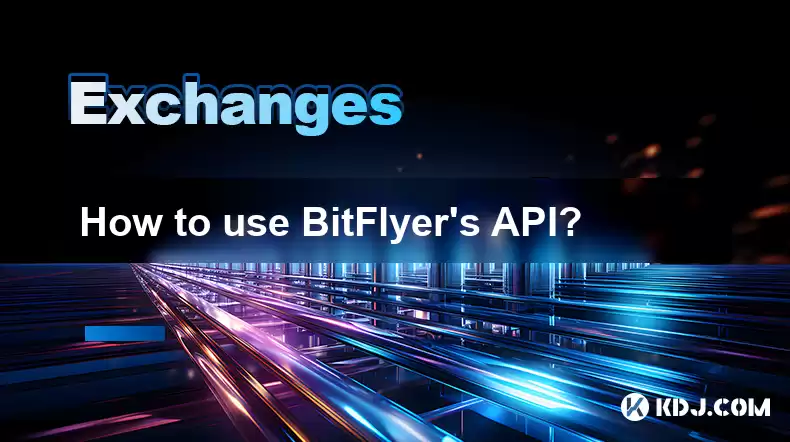-
 bitcoin
bitcoin $87959.907984 USD
1.34% -
 ethereum
ethereum $2920.497338 USD
3.04% -
 tether
tether $0.999775 USD
0.00% -
 xrp
xrp $2.237324 USD
8.12% -
 bnb
bnb $860.243768 USD
0.90% -
 solana
solana $138.089498 USD
5.43% -
 usd-coin
usd-coin $0.999807 USD
0.01% -
 tron
tron $0.272801 USD
-1.53% -
 dogecoin
dogecoin $0.150904 USD
2.96% -
 cardano
cardano $0.421635 USD
1.97% -
 hyperliquid
hyperliquid $32.152445 USD
2.23% -
 bitcoin-cash
bitcoin-cash $533.301069 USD
-1.94% -
 chainlink
chainlink $12.953417 USD
2.68% -
 unus-sed-leo
unus-sed-leo $9.535951 USD
0.73% -
 zcash
zcash $521.483386 USD
-2.87%
How to use BitFlyer's API?
BitFlyer's API empowers traders and developers to automate trading or integrate services, guiding users from account setup to executing trades programmatically.
Apr 16, 2025 at 04:42 am

Using BitFlyer's API can be a powerful tool for traders and developers looking to automate their trading strategies or integrate BitFlyer's services into their applications. In this article, we will guide you through the process of using BitFlyer's API, from setting up an account to executing trades programmatically.
Registering and Setting Up Your BitFlyer Account
Before you can use BitFlyer's API, you need to have an account with BitFlyer. Here are the steps to get started:
- Visit the BitFlyer website and click on the 'Sign Up' button.
- Fill out the registration form with your personal information, including your name, email address, and password.
- Complete the verification process, which may involve providing identification documents.
- Once your account is verified, log in to your BitFlyer account.
Obtaining API Keys
To use BitFlyer's API, you need to generate API keys. Here's how to do it:
- Log in to your BitFlyer account and navigate to the 'API' section.
- Click on 'Create New API Key'.
- Enter a name for your API key to help you remember its purpose.
- Choose the permissions you want to grant to this API key. For trading, you will need to select 'Trade' and 'Withdraw'.
- Confirm the creation of the API key and securely store the API Key and API Secret. These will be used to authenticate your API requests.
Understanding BitFlyer's API Endpoints
BitFlyer's API is divided into several endpoints that serve different purposes. Here are the main categories:
- Public Endpoints: These do not require authentication and are used to fetch market data, such as ticker information, order books, and trade history.
- Private Endpoints: These require authentication and are used for actions like placing orders, checking your balance, and managing your account.
Making API Requests
To interact with BitFlyer's API, you will need to send HTTP requests to the appropriate endpoints. Here's a basic guide on how to do this:
- Choose an HTTP client: You can use tools like cURL, Python's
requestslibrary, or any other HTTP client that supports sending requests. - Construct the API URL: The base URL for BitFlyer's API is
https://api.bitflyer.com/v1/. Append the specific endpoint to this base URL. For example, to get the ticker information, you would usehttps://api.bitflyer.com/v1/ticker. - Add Authentication (for private endpoints): For private endpoints, you need to add authentication headers. Use the API Key and API Secret to generate a signature and include it in the
ACCESS-SIGNheader. Here's a basic example using Python:
import hmacimport hashlibimport timeimport requests
api_key = 'YOUR_API_KEY'api_secret = 'YOUR_API_SECRET'timestamp = str(int(time.time()))
method = 'GET'endpoint = '/v1/me/getbalance'uri_path = '/v1' + endpoint
text = timestamp + method + uri_pathsign = hmac.new(bytes(api_secret.encode('ascii')), bytes(text.encode('ascii')), hashlib.sha256).hexdigest()
headers = {
'ACCESS-KEY': api_key,
'ACCESS-TIMESTAMP': timestamp,
'ACCESS-SIGN': sign,
'Content-Type': 'application/json'
}
response = requests.request(method, 'https://api.bitflyer.com' + uri_path, headers=headers)print(response.json())
Placing Orders Using the API
To place an order using BitFlyer's API, you need to use the private endpoint for sending orders. Here's how to do it:
- Choose the order type: BitFlyer supports various order types, such as market orders, limit orders, and stop orders.
- Prepare the order data: You will need to specify the product code (e.g., 'BTC_JPY'), the order type, and other relevant parameters like price and quantity.
- Send the order request: Use the
/v1/me/sendchildorderendpoint to place the order. Here's an example using Python:
import hmacimport hashlibimport timeimport requestsimport json
api_key = 'YOUR_API_KEY'api_secret = 'YOUR_API_SECRET'timestamp = str(int(time.time()))
method = 'POST'endpoint = '/v1/me/sendchildorder'uri_path = '/v1' + endpoint
order_data = {
'product_code': 'BTC_JPY',
'child_order_type': 'LIMIT',
'side': 'BUY',
'price': 5000000,
'size': 0.01
}
body = json.dumps(order_data)
text = timestamp + method + uri_path + bodysign = hmac.new(bytes(api_secret.encode('ascii')), bytes(text.encode('ascii')), hashlib.sha256).hexdigest()
headers = {
'ACCESS-KEY': api_key,
'ACCESS-TIMESTAMP': timestamp,
'ACCESS-SIGN': sign,
'Content-Type': 'application/json'
}
response = requests.request(method, 'https://api.bitflyer.com' + uri_path, headers=headers, data=body)print(response.json())
Managing Your Orders
Once you have placed orders, you may need to manage them, such as canceling orders or checking their status. Here's how to do it:
- Canceling an Order: Use the
/v1/me/cancelchildorderendpoint. You will need to specify the product code and the order ID or the parameters used to place the order.
import hmacimport hashlibimport timeimport requestsimport json
api_key = 'YOUR_API_KEY'api_secret = 'YOUR_API_SECRET'timestamp = str(int(time.time()))
method = 'POST'endpoint = '/v1/me/cancelchildorder'uri_path = '/v1' + endpoint
cancel_data = {
'product_code': 'BTC_JPY',
'child_order_acceptance_id': 'YOUR_ORDER_ID'
}
body = json.dumps(cancel_data)
text = timestamp + method + uri_path + bodysign = hmac.new(bytes(api_secret.encode('ascii')), bytes(text.encode('ascii')), hashlib.sha256).hexdigest()
headers = {
'ACCESS-KEY': api_key,
'ACCESS-TIMESTAMP': timestamp,
'ACCESS-SIGN': sign,
'Content-Type': 'application/json'
}
response = requests.request(method, 'https://api.bitflyer.com' + uri_path, headers=headers, data=body)print(response.json())
- Checking Order Status: Use the
/v1/me/getchildordersendpoint to fetch the status of your orders.
import hmacimport hashlibimport timeimport requests
api_key = 'YOUR_API_KEY'api_secret = 'YOUR_API_SECRET'timestamp = str(int(time.time()))
method = 'GET'endpoint = '/v1/me/getchildorders'uri_path = '/v1' + endpoint
params = {
'product_code': 'BTC_JPY',
'child_order_state': 'ACTIVE'
}
text = timestamp + method + uri_path + '?' + '&'.join([f'{k}={v}' for k, v in params.items()])sign = hmac.new(bytes(api_secret.encode('ascii')), bytes(text.encode('ascii')), hashlib.sha256).hexdigest()
headers = {
'ACCESS-KEY': api_key,
'ACCESS-TIMESTAMP': timestamp,
'ACCESS-SIGN': sign,
'Content-Type': 'application/json'
}
response = requests.request(method, 'https://api.bitflyer.com' + uri_path, headers=headers, params=params)print(response.json())
Frequently Asked Questions
Q: Can I use BitFlyer's API on different programming languages?A: Yes, BitFlyer's API can be used with various programming languages. You need an HTTP client library that supports sending requests and handling authentication. Examples include Python's requests library, JavaScript's axios, and many others.
A: Yes, BitFlyer has rate limits on their API to prevent abuse. The exact limits may vary, so it's important to check BitFlyer's documentation for the most current information. Exceeding these limits may result in temporary bans or restrictions on your account.
Q: How secure is it to use BitFlyer's API?A: Using BitFlyer's API is secure as long as you follow best practices for API security. Always keep your API keys and secrets confidential, use HTTPS for all communications, and implement proper error handling and logging to monitor for suspicious activity.
Q: Can I use BitFlyer's API for automated trading strategies?A: Yes, BitFlyer's API is designed to support automated trading strategies. You can use it to fetch market data, place orders, and manage your positions programmatically, allowing you to implement complex trading algorithms and bots.
Disclaimer:info@kdj.com
The information provided is not trading advice. kdj.com does not assume any responsibility for any investments made based on the information provided in this article. Cryptocurrencies are highly volatile and it is highly recommended that you invest with caution after thorough research!
If you believe that the content used on this website infringes your copyright, please contact us immediately (info@kdj.com) and we will delete it promptly.
- Coinbase, Crypto, and Tailwinds: Navigating the Shifting Sands of the Digital Economy
- 2025-12-07 01:35:01
- Decoding Bitcoin's Current Crossroads: ETF Flows, Institutional Sentiment, and the Path Ahead
- 2025-12-07 01:30:01
- Base's Solana Bridge: Vampire Attack or Multichain Pragmatism Fueling SOL Liquidity?
- 2025-12-07 01:30:01
- Bitcoin, Treasury Firms, and Global Markets: Navigating the Future of Finance
- 2025-12-07 01:25:01
- Bitcoin, Ethereum, and Solana: Riding the Crypto Wave in 2024
- 2025-12-07 01:25:01
- Stablecoin Adoption: Explosive Growth, Future Trends, and What's Next
- 2025-12-06 23:30:01
Related knowledge

A Full Guide to Using the Binance Mobile App's P2P Features
Dec 02,2025 at 05:59pm
Understanding Binance P2P on Mobile1. The Binance mobile app provides a peer-to-peer (P2P) trading platform that allows users to buy and sell cryptocu...

How to Transfer Crypto Between Your Spot and Futures Wallet on Bybit
Dec 04,2025 at 05:59pm
Understanding Wallet Segmentation on Bybit1. Bybit operates with separate wallets for different trading functions—Spot, Futures, and Unified accounts....

How to Read Candlestick Charts on the Binance Trading Interface
Dec 06,2025 at 04:40am
Understanding the Basics of Candlestick Charts1. Each candlestick on the Binance trading interface represents a specific time interval, such as one mi...

How to Stake Algorand (ALGO) on the Gemini Exchange
Dec 02,2025 at 09:19am
Understanding Algorand Staking on GeminiStaking Algorand (ALGO) on the Gemini exchange allows users to earn passive income by locking their tokens to ...

A Step-by-Step Guide to Submitting a Support Ticket on Coinbase
Dec 04,2025 at 09:19pm
How to Access the Coinbase Support Portal1. Navigate to the official Coinbase website using a secure internet connection. Ensure that the URL begins w...

How to Use the Bybit Mutual Insurance for Futures Trading
Dec 04,2025 at 09:00am
Understanding Bybit Mutual Insurance in Futures Trading1. The Bybit Mutual Insurance system acts as a safety net for traders engaged in futures contra...

A Full Guide to Using the Binance Mobile App's P2P Features
Dec 02,2025 at 05:59pm
Understanding Binance P2P on Mobile1. The Binance mobile app provides a peer-to-peer (P2P) trading platform that allows users to buy and sell cryptocu...

How to Transfer Crypto Between Your Spot and Futures Wallet on Bybit
Dec 04,2025 at 05:59pm
Understanding Wallet Segmentation on Bybit1. Bybit operates with separate wallets for different trading functions—Spot, Futures, and Unified accounts....

How to Read Candlestick Charts on the Binance Trading Interface
Dec 06,2025 at 04:40am
Understanding the Basics of Candlestick Charts1. Each candlestick on the Binance trading interface represents a specific time interval, such as one mi...

How to Stake Algorand (ALGO) on the Gemini Exchange
Dec 02,2025 at 09:19am
Understanding Algorand Staking on GeminiStaking Algorand (ALGO) on the Gemini exchange allows users to earn passive income by locking their tokens to ...

A Step-by-Step Guide to Submitting a Support Ticket on Coinbase
Dec 04,2025 at 09:19pm
How to Access the Coinbase Support Portal1. Navigate to the official Coinbase website using a secure internet connection. Ensure that the URL begins w...

How to Use the Bybit Mutual Insurance for Futures Trading
Dec 04,2025 at 09:00am
Understanding Bybit Mutual Insurance in Futures Trading1. The Bybit Mutual Insurance system acts as a safety net for traders engaged in futures contra...
See all articles










































































